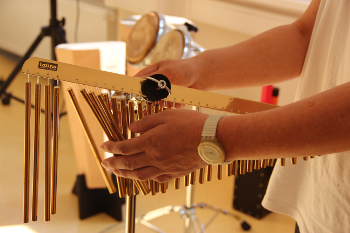Motor applications of the Neurological Music Therapy® according to Thaut.
Gait training with music - RAS

The rehabilitative gait training (e.g., stroke, Parkinson's disease, traumatic brain injury, hip surgery, etc.) is made more effective with music. A so-called RAS™ (Rhythmic Acoustic Stimulation) is used. This is presented by a metronome or as music via headphones. The tempo and structure of the Training music be adapted to the disturbed gait pattern.
The digital therapy protocol for RAS™ gait training. With integrated formula editor.
Instrumental play as movement training
By playing on musical instruments even musically inexperienced patients can effectively train movements of arms, torso, hands, fingers and others. Various Musical instruments such as drums, stick games, piano or melodica are used for musical movement exercises to optimize. The arrangement of the instruments and the musical stimulation - played live by the therapist on the piano - ensure that the same movement is practiced again and again.
Fine motor skills training on the piano in Parkinson's - an excellent way to maintain and train the important mobility of the fingers and hands. The piano training is controlled rhythmically so that optimal and selective finger mobility is promoted and unfavorable movements and rigidity are inhibited.
Such repetitive training represents a highly promising approach in rehabilitation therapy, especially when additional deficits (neglect, spasticity, attention deficit disorders, etc.) hinder training progress. With therapist guidance, even severely paralyzed muscles can be effectively trained. In neurological music therapy, this technique is called TIMP™ (Therapeutic Instrumental Musical Playing).
Music therapy sequence training

In this training, the patient practices a complex movement or sequence of movements (e.g., from sitting to standing, handling an object, etc.) with the support of a specially composed piece of music. All of the movements are incorporated into a so-called kinematic melody. The treatment technique is called Patterned sensory enhancement™. Musical patterns supported specific aspects of a movement – such as range of motion.
This special music enables better motor control. In addition, the training can be experienced acoustically and aesthetically. This supports the mental learning process. Last but not least, training is more fun. Endurance and motivation are increased. See Beelitz Music Gym.